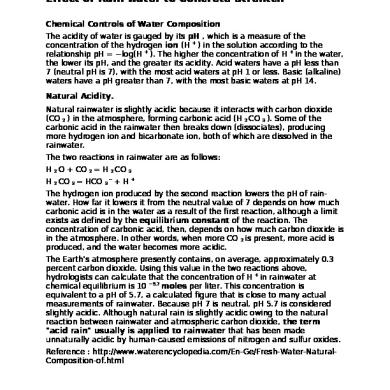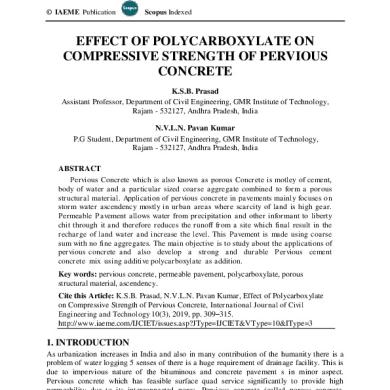Effect Of Rain Water To Concrete Strength
This document was uploaded by user and they confirmed that they have the permission to share it. If you are author or own the copyright of this book, please report to us by using this DMCA report form. Report DMCA
Overview
Download & View Effect Of Rain Water To Concrete Strength as PDF for free.
More details
- Words: 683
- Pages: 2
Effect of Rain water to Concrete Strentch Chemical Controls of Water Composition The acidity of water is gauged by its pH , which is a measure of the concentration of the hydrogen ion (H + ) in the solution according to the relationship pH = −log(H + ). The higher the concentration of H + in the water, the lower its pH, and the greater its acidity. Acid waters have a pH less than 7 (neutral pH is 7), with the most acid waters at pH 1 or less. Basic (alkaline) waters have a pH greater than 7, with the most basic waters at pH 14. Natural Acidity. Natural rainwater is slightly acidic because it interacts with carbon dioxide (CO 2 ) in the atmosphere, forming carbonic acid (H 2 CO 3 ). Some of the carbonic acid in the rainwater then breaks down (dissociates), producing more hydrogen ion and bicarbonate ion, both of which are dissolved in the rainwater. The two reactions in rainwater are as follows: H 2 O + CO 2 = H 2 CO H 2 CO 3 = HCO
3
−
3
+H
+
The hydrogen ion produced by the second reaction lowers the pH of rainwater. How far it lowers it from the neutral value of 7 depends on how much carbonic acid is in the water as a result of the first reaction, although a limit exists as defined by the equilibrium constant of the reaction. The concentration of carbonic acid, then, depends on how much carbon dioxide is in the atmosphere. In other words, when more CO 2 is present, more acid is produced, and the water becomes more acidic. The Earth's atmosphere presently contains, on average, approximately 0.3 percent carbon dioxide. Using this value in the two reactions above, hydrologists can calculate that the concentration of H + in rainwater at chemical equilibrium is 10 −5.7 moles per liter. This concentration is equivalent to a pH of 5.7, a calculated figure that is close to many actual measurements of rainwater. Because pH 7 is neutral, pH 5.7 is considered slightly acidic. Although natural rain is slightly acidic owing to the natural reaction between rainwater and atmospheric carbon dioxide, the term "acid rain" usually is applied to rainwater that has been made unnaturally acidic by human-caused emissions of nitrogen and sulfur oxides. Reference : http://www.waterencyclopedia.com/En-Ge/Fresh-Water-NaturalComposition-of.html
Water Combining water with a cementitious material forms a cement paste by the process of hydration. The cement paste glues the aggregate together, fills voids within it, and allows it to flow more freely. Less water in the cement paste will yield a stronger, more durable concrete; more water will give an freer-flowing concrete with a higher slump.[11] Impure water used to make concrete can cause problems when setting or in causing premature failure of the structure. Reference : http://en.wikipedia.org/wiki/Concrete Deterioration of concrete structures by acid deposition — an assessment of the role of rainwater on deterioration by laboratory and field exposure experiments using mortar specimens Deterioration of concrete structures caused by acid deposition was investigated by laboratory and field exposure of portland cement mortar specimens to acid deposition. Laboratory exposure experiment showed that the dissolved amount of calcium hydrates, which were the major components in mortar, increased with the increase in the acidity of simulated acid rain solution and the decrease in the flow rate. There was little difference in their amount among different temperature treatments after each exposure to the solution with the same acidity, namely left at room temperature, heated at 70°C, and cooled at −2°C. The neutralization progressed more deeply under the heated and cooled condition and was accelerated by even acid rain with pH 4.7 during a long period (90 exposure cycles, which correspond to the rainfall amount of 15 years in Japan). A field exposure experiment for two years indicated that the carbonation of calcium hydrates and the formation of other corrosion products such as chloride, nitrate, and sulfate were limited to the surface of mortar specimens. The neutralization progressed more deeply in mortar specimens sheltered from rainwater than in those washed by rainwater.
3
−
3
+H
+
The hydrogen ion produced by the second reaction lowers the pH of rainwater. How far it lowers it from the neutral value of 7 depends on how much carbonic acid is in the water as a result of the first reaction, although a limit exists as defined by the equilibrium constant of the reaction. The concentration of carbonic acid, then, depends on how much carbon dioxide is in the atmosphere. In other words, when more CO 2 is present, more acid is produced, and the water becomes more acidic. The Earth's atmosphere presently contains, on average, approximately 0.3 percent carbon dioxide. Using this value in the two reactions above, hydrologists can calculate that the concentration of H + in rainwater at chemical equilibrium is 10 −5.7 moles per liter. This concentration is equivalent to a pH of 5.7, a calculated figure that is close to many actual measurements of rainwater. Because pH 7 is neutral, pH 5.7 is considered slightly acidic. Although natural rain is slightly acidic owing to the natural reaction between rainwater and atmospheric carbon dioxide, the term "acid rain" usually is applied to rainwater that has been made unnaturally acidic by human-caused emissions of nitrogen and sulfur oxides. Reference : http://www.waterencyclopedia.com/En-Ge/Fresh-Water-NaturalComposition-of.html
Water Combining water with a cementitious material forms a cement paste by the process of hydration. The cement paste glues the aggregate together, fills voids within it, and allows it to flow more freely. Less water in the cement paste will yield a stronger, more durable concrete; more water will give an freer-flowing concrete with a higher slump.[11] Impure water used to make concrete can cause problems when setting or in causing premature failure of the structure. Reference : http://en.wikipedia.org/wiki/Concrete Deterioration of concrete structures by acid deposition — an assessment of the role of rainwater on deterioration by laboratory and field exposure experiments using mortar specimens Deterioration of concrete structures caused by acid deposition was investigated by laboratory and field exposure of portland cement mortar specimens to acid deposition. Laboratory exposure experiment showed that the dissolved amount of calcium hydrates, which were the major components in mortar, increased with the increase in the acidity of simulated acid rain solution and the decrease in the flow rate. There was little difference in their amount among different temperature treatments after each exposure to the solution with the same acidity, namely left at room temperature, heated at 70°C, and cooled at −2°C. The neutralization progressed more deeply under the heated and cooled condition and was accelerated by even acid rain with pH 4.7 during a long period (90 exposure cycles, which correspond to the rainfall amount of 15 years in Japan). A field exposure experiment for two years indicated that the carbonation of calcium hydrates and the formation of other corrosion products such as chloride, nitrate, and sulfate were limited to the surface of mortar specimens. The neutralization progressed more deeply in mortar specimens sheltered from rainwater than in those washed by rainwater.
Related Documents

Effect Of Rain Water To Concrete Strength
June 2020 7
High Strength Concrete
November 2019 43
Effect Of Acid On Strength Of Concrete.pdf
April 2020 9
Effect Of Emf In Water
June 2020 14
